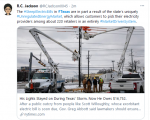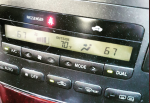Chuck DeVore: Texas' blackouts – here's the truth about why they happened and what we have to do next | Fox News
OPINION
Published 2 hours ago
Chuck DeVore: Texas' blackouts – here's the truth about why they happened and what we have to do next
There are two general reasons for Texas’ prolonged power outages
As Texas entered a deep freeze on Feb. 14, Dallas, Austin and San Antonio broke seven record lows over three days. Ice-laden trees snapped power lines. Wind turbines ground to a halt while some reliable natural gas, coal and nuclear plants failed to get
energy to the grid. Electricity demand hit an all-time high – but the supply wasn’t available, plunging some four million Texans into the cold and darkness.
As massive gas-powered turbines spun down across
Texas and the lights went out, an aggressive narrative spun up: the electric grid failed in Texas, not because wind and solar failed, but due to a lack of regulatory power to force the electric industry – from natural gas producers to pipeline operators to power generators, and lastly, the transmission line firms – to winterize. It was a failure of Texas’ unregulated free market. And further, this extreme weather event was a harbinger of more to come due to climate change, necessitating even more wind and solar power.
This narrative, pushed out by the renewable industry and environmentalists, found a sympathetic mouthpiece in
corporate media.
The narrative is wrong.
There are three electric grids in the continental U.S with Texas having its own grid providing power to about 90% of Texans. This electrical independence allows Texans to escape a certain amount of federal meddling in its electric affairs – though it also makes Texans largely responsible for their own problems.
Addressing those problems, the Texas Legislature held marathon hearings a week after the freeze. That testimony, and an increasing flow of information from operators on the ground, has produced a more complete picture of what went wrong during a storm that plunged Texas into a deep freeze colder than most of Alaska.
There are two general reasons for Texas’ prolonged power outages, one proximate to the storm and involving a series of on-the-ground mistakes and cold-related failures, and one the result of long-term policy.
However, it was the policy failures over 20 years that allowed the storm-related failures to become persistent and deadly.
It’s important to note that had every Texas generator powered by natural gas, coal, nuclear and hydro operated at full output during the height of the storm’s demand, Texas still would have experienced planned blackouts. That Texas’ grid has become increasingly dependent on unreliable wind and solar is largely to blame for this critical shortfall.
Federal and state tax policy have encouraged the overbuilding of wind, and to a lesser extent, solar power, resulting in cheap, subsidized power flooding the Texas grid. This inexpensive but unreliable power has acted as a powerful disincentive to build needed natural gas power plants.
In the past five years, Texas saw an increase of about 20,000 megawatts of installed wind and solar capacity with a net loss of 4,000 megawatts of gas and coal-fired powerplants. This 4,000 megawatts, had it been built or not prematurely retired, would have saved lives during the 2021 St. Valentine’s Day Storm.
Because ERCOT, Texas’ grid operator, didn’t have enough reliable safety margin meant that when things started to go wrong on early Monday morning, they got worse fast.
So, did the unusually cold weather cause power plant failures?
We know that wind turbines were affected, with half of them freezing up. Over the course of 2019, Texas wind produced about 34% of its capacity – from hour-to-hour and season-to-season, sometimes more than 70%, sometimes close to zero. At one point during the storm, solar was producing no electricity while wind produced about 1% of its potential output. Since electricity must be produced the moment it is needed, that meant that natural gas power plants had to make up the shortfall.
The emerging data from thermal – gas, coal, and nuclear – power plants suggests that there were some cold-related failures. But, as ERCOT struggled to keep the lights on, the grid became unstable, tripping additional power plants offline to protect their massive generators from destructive interaction with a fluctuating line frequency.
As ERCOT issued the order to start load shedding – rotating blackouts – some of the darkened circuits included vital oil and gas infrastructure. This uncoordinated move starved natural gas power plants of their fuel – leading to a further loss of power and the widespread and incorrect rumor that wellhead and pipeline freeze off contributed to the disaster.
When these systems lost power, gas production dropped 75%. An Obama-era environmental rule that forced oilfield compressors to switch from natural gas to electric likely made things worse. Eventually, power was restored, and natural gas production ramped back up to meet electricity generation demand.
Winter isn’t over, but Texas – and California and other Western states – are at increased risk of blackouts this summer. This is due to policy that favors unreliables – wind and solar – over reliable electricity from gas, coal and nuclear.
In Texas, it’s an overbuilding of wind. In California, an overbuilding of mandated solar. In both states, this has caused the grid to become increasingly at risk of blackouts at times when nature doesn’t cooperate.
As America builds more wind and solar – with a renewed push from the Biden administration –the costs to prevent blackouts will mount in the form of massive battery farms to store power or increasingly large numbers of backup gas power plants. Instead, we should end subsidies for all energy sources while making wind and solar pay for the reliability costs they impose on the grid.


/cloudfront-us-east-1.images.arcpublishing.com/gray/2FUCBYYEENF53DQA3UOZHHVX4A.BMP)







